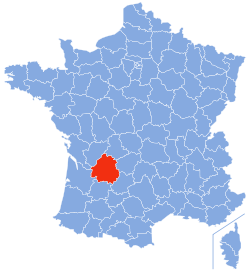Dordogne
French department in New Aquitaine From Wikipedia, the free encyclopedia
French department in New Aquitaine From Wikipedia, the free encyclopedia
Dordogne (Occitan: Dordonha) is a department in the southwest of France. It is named after the Dordogne river that runs through the department.
Dordogne | |
|---|---|
 Prefecture building of the Dordogne department, in Périgueux | |
 Location of Dordogne in France | |
| Coordinates: 45°0′N 0°40′E | |
| Country | France |
| Region | Nouvelle-Aquitaine |
| Département | 4 March 1790 |
| Prefecture | Périgueux |
| Subprefectures | Bergerac, Nontron, Sarlat-la-Canéda |
| Government | |
| • President | Germinal Peiro[1] |
| Area | |
| • Total | 9,060 km2 (3,500 sq mi) |
| Population (2014)[3] | |
| • Total | 416,350 |
| • Density | 46/km2 (120/sq mi) |
| Demonym(s) | Dordognots, Périgordins |
| Time zone | UTC+1 (CET) |
| • Summer (DST) | UTC+2 (CEST) |
| ISO 3166 code | FR-24 |
| Arrondissements | 4 |
| Cantons | 25 |
| Communes | 545 |
| Website | www.dordogne.fr |
The department is in the region of Nouvelle-Aquitaine. It is between the valley of the Loire river and the Pyrenees. Its prefecture (capital) is Périgueux.
Dordogne was formed during the French Revolution on 4 March 1790 with parts of the old province of Périgord. It was divided into nine districts: Belvès, Bergerac, Excideuil, Montignac, Montpon, Nontron, Périgueux, Ribérac and Sarlat.[4]
Bergerac, Périgueux and Sarlat-la-Canéda were alternatively the capital of the department but later it was decided that only Périgueux would be the capital.[4]
Dordogne is part of the Nouvelle-Aquitaine region. It is the third largest department of Metropolitan France, after Gironde and Landes. It has an area of 9,060 km2 (3,498 sq mi).[2]
The department is bordered by seven departments in two regions:
The main river in the department is the Dordogne that gives its name to the department. It runs from east to west through the department. Other rivers are the Isle and the Vézère, both tributaries of the Dordogne.
The highest point in the department is the southwestern summit of the Forêt de Vieillecour (45°34′41″N 1°1′55″E), in northwestern Massif Central near the border with the Haute-Vienne department, with an altitude of 475 m (1,558 ft).[5] The lowest point is in the valley of the Dordogne river and is 16 m (52 ft) high.[6]
Dordogne is part of the region of Nouvelle-Aquitaine. It is managed by the Departamental Council of Dordogne in Périgueux.
There are 4 arrondissements (districts), 25 cantons and 520 communes (municipalities) in Dordogne.[7]
The following is a list of the 25 cantons of the Dordogne department (with their INSEE codes), following the French canton reorganisation which came into effect in March 2015:[11]
The inhabitants of Dordogne are known, in French, as Dordognais (women: Dordognaises).[12] They are also known as Périgordins or Périgoudins.
in 2014, the department of Dordogne had a population of 416,350,[3] for a population density of 46.0 inhabitants/km2. The arrondissement of Périgueux, with 189,301 inhabitants, is by far the largest. The other three, Bergerac, Nontron and Sarlat-la-Canéda, have respectively 111,875, 40,508 and 74,666 inhabitants.[8]
Evolution of the population in Dordogne

The cities in the department with more of 5,000 inhabitants are:
| City | Population[8] (2014) |
Arrondissement |
|---|---|---|
| Périgueux | 30,069 | Périgueux |
| Bergerac | 27,764 | Bergerac |
| Boulazac Isle Manoire | 9,823 | Périgueux |
| Sarlat-la-Canéda | 9,127 | Sarlat-la-Canéda |
| Coulounieix-Chamiers | 8,089 | Périgueux |
| Trélissac | 6,732 | Périgueux |
| Terrasson-Lavilledieu | 6,186 | Sarlat-la-Canéda |
| Saint-Astier | 5,521 | Périgueux |
| Montpon-Ménestérol | 5,480 | Périgueux |
Seamless Wikipedia browsing. On steroids.
Every time you click a link to Wikipedia, Wiktionary or Wikiquote in your browser's search results, it will show the modern Wikiwand interface.
Wikiwand extension is a five stars, simple, with minimum permission required to keep your browsing private, safe and transparent.